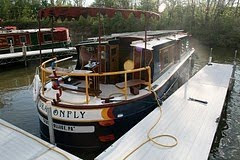 |
| Crab pot buoys are really kind of pretty. Some folks string 'em on rope to decorate their porches. Boaters hate 'em |
Other Loopers warned us: "In this stretch of water, watch out for crab pots!" To answer a question received off-blog, here's a short treatise on "everything you always wanted to know about crab pot floats" . . . and why they strike fear in the hearts of boaters.
Commercial crab fishermen ("crabbers") use "pots" or traps--round or square mesh boxes. Crabs find their way in but they can't find their way out. (Click here for pictures of stone crab traps.) Best bait: a fish head or pig's feet. By law, these crab pots must be marked by crab pot buoys--little round styrofoam floats, smaller than a soccer ball. They come in a rainbow of solid colors and stylish stripes. Each buoy must display its "state-issued stone crab endorsement number." (Kind of like a trout fisherman has to wear his fishing license pinned to his vest, in case the warden comes around.)
 |
| Crab pots to the right of me! Crab pots to the left! |
If you pilot your boat close to a crab pot buoy, and if the water is calm and clear, you'll see the line slanting away from the buoy, down to the trap. Depending on the current and the stage of the tide and how much extra rope was used to set the buoy, the line might slant at rather a shallow angle . . . toward your boat . . . just under the surface of the water. In other words, the perfect set-up to catch on your propellor. The line gets wound tight in a matter of seconds, and there you are--dead in the water.
So, give buoys a wide berth, right? Not that simple. In places, there are so many buoys, you are kind of threading a maze. Another problem: Sometimes it's really hard to SEE the buoys. If there's a bit of a chop, they can disappear behind the waves. Buoys that are backlit look dark and blend with the water's surface. And if your course takes you into the sun, the buoys are completely hidden.
 |
| Can you spot the crab-pot buoy in THIS picture? |
But on the Tenn-Tom, we met a guy in a sailboat who'd had the actual experience of snagging a crab pot on his little outboard.
"Yeah," he said. "We pulled up the trap, cut the line, and just pulled it off the prop. Then we had crabs for dinner."
More about Tarpon Springs tomorrow. But if you just can't wait, check the photos on Facebook.





Do you not have a weed hatch? This is an essential feature on UK canal boats that allows you to access the prop shaft when you have run over some water weed. It is a raised square section of hull which the prop shaft runs through (sort of like a moon pool in a drill ship, but with a lid).
ReplyDelete